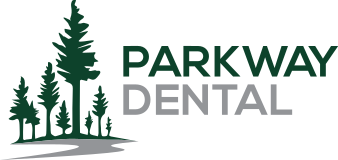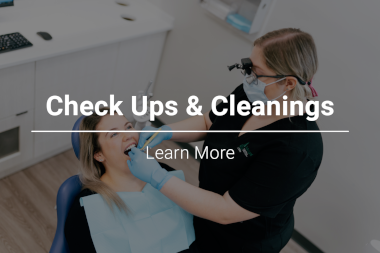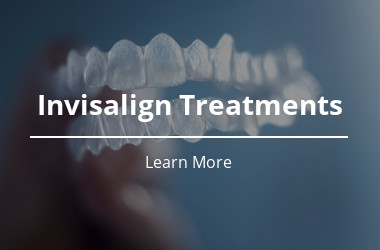Dental Braces in Langford
For Long Lasting Oral Health
Braces were once considered to be primarily for adolescents or for complex dental cases. These days, however, adolescents as well as adult professionals are choosing to have traditional orthodontics installed.
Traditional braces are comprised of metal brackets which have an arch wire threaded through them to exert pressure on the ligaments, gums and bone that support the teeth as well as the teeth themselves. The force exerted on the structures of the mouth have the effect of moving the teeth and jaw into a desired position, usually with a goal to improve the bite. Teeth are able to make these positional changes because of the ligaments that attach them to the bony structure of the jaw. These ligaments allow small transitions to be made repetitively over time. Each time the ligament is moved it changes in shape to accommodate the change and then signals the bone to remineralize around the new position.
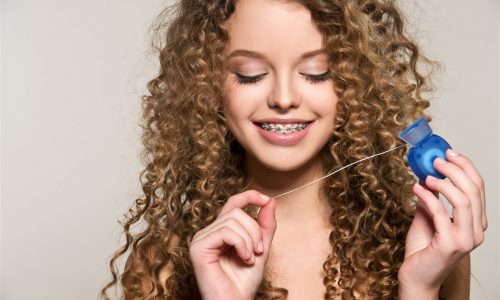
Dental Braces in Langford
For Long Lasting Oral Health
Braces were once considered to be primarily for adolescents or for complex dental cases. These days, however, adolescents as well as adult professionals are choosing to have traditional orthodontics installed.
Traditional braces are comprised of metal brackets which have an arch wire threaded through them to exert pressure on the ligaments, gums and bone that support the teeth as well as the teeth themselves. The force exerted on the structures of the mouth have the effect of moving the teeth and jaw into a desired position, usually with a goal to improve the bite. Teeth are able to make these positional changes because of the ligaments that attach them to the bony structure of the jaw. These ligaments allow small transitions to be made repetitively over time. Each time the ligament is moved it changes in shape to accommodate the change and then signals the bone to remineralize around the new position.

What Can Braces Treat?
Braces are primarily used to treat malocclusion, that is, misalignment of the teeth. When teeth are well aligned, they assist in correct speech and pronunciation, are easier to clean, provide an esthetically pleasing smile and function effectively when chewing. Common kinds of malocclusion treated with braces include:
Overbite – Jaw is recessed toward the ears.
Underbite – Jaw protrudes beyond the front teeth.
Deep bite – Front top teeth cover more than 25% of bottom front teeth.
Open bite – Upper and lower front teeth do not meet when jaw is fully closed.
Cross Bite – Back teeth are too far toward the cheek or inward toward the tongue, resulting in a misaligned bite.
Patients may pursue braces for the esthetic outcome, however, correct alignment can positively impact a patient’s overall health. Pain associated with temporomandibular disorder can be lessened by treating the mechanics of the bite and may subsequently reduce unconscious grinding or clenching of the jaw.
Patients experiencing recurrent or chronic periodontal disease may have their symptoms reduced drastically or eliminated once the teeth have been brought into proper relationship with one another. In an ideal relationship, teeth support one another from edge-to-edge and assist with distributing bite force across the dental arches evenly. Gingival tissue, too, is evenly distributed with fewer gaps or crowded spaces to protect. Oral hygiene is improved dramatically, as each tooth is brushed and flossed much more effectively with proper dental occlusion.
Who Can Apply Braces?
Braces can be installed and managed by orthodontists, or general dentists who have received additional training on how to correct the bite.
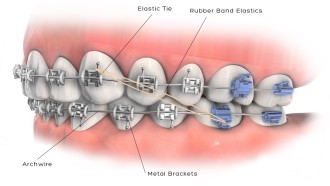
How Long Before They Can Be Removed?
Braces are usually worn for between 18 to 24 months; however, the term of treatment is directly impacted by the severity of malocclusion being treated and patient compliance. Braces require you to be seen by your dentist regularly for adjustments, and other appliances such as head gear, retainers or elastics to be worn regularly. Deviating from your dentist’s recommendations can result in a longer term of treatment.
Request An Appointment At Parkway Dental Today!
Book your dentist appointment online. Select the next convenient time or book ahead to your preferred date. We look forward to seeing you!
Other Kinds of Braces
When we refer to braces in common speech, we usually mean traditional metal braces. While this has been the most common kind of braces in the past, new technologies are offering new alternatives to the traditional model.
Ceramic Braces – These braces are similar to metal braces in form and function, but the ceramic material that they use can be tinted to match the precise colour of your tooth’s enamel. The effect makes the brackets look mostly clear.
Lingual braces – Again these are metal braces, but rather than attaching to the outside perimeter of the dental arch, these braces are placed on the inside of the teeth toward the tongue. These braces allow the appliance to be less visible, however, discomfort and challenging speech are sometimes the tradeoff.
Invisalign® Treatment – Invisalign is a newer dental brace which utilizes a series of transparent aligners to straighten teeth over time. The aligners are a great alternative to traditional braces for mild to moderate malocclusion, but for severe malocclusion traditional braces are required.
Are Braces Painful?
The process of installing metal braces is not painful, soon after returning home, however, you could find yourself experiencing some discomfort. This is because the device has started to exert pressure on the teeth, gums, and bone and those tissues are beginning to respond to that pressure. This pain is typically resolved after the first week, when the changes and pressure on the teeth are most ‘new’. Subsequent tenderness can occur after adjustments but should be less uncomfortable and for a shorter duration.
Metal braces can sometimes become painful where they are rubbing or scratching on the soft tissues of the mouth. Your dentist will provide you with a special dental wax to place over the metal appliance where it is causing pain to the cheek or other soft tissue. Numbing gels can also assist with tolerating discomfort associated with metal braces.
Parkway Dental Services
Parkway Dental Clinic offers a full range of dental services in Langford. From Checkups & Cleanings to Invisalign to Cosmetic Dentistry!
Time To See A Dentist?
Schedule An Appointment
Book your dentist appointment online. Select the next convenient time or book ahead to your preferred date. We look forward to seeing you!
We Will See You Soon!
Our Contact Info
961 Langford Parkway
Langford, BC V9B 0A5
1-778-433-7732
When to visit us?
Clinic Hours
Closed: Weekends & Holidays
